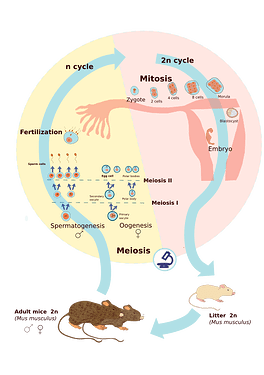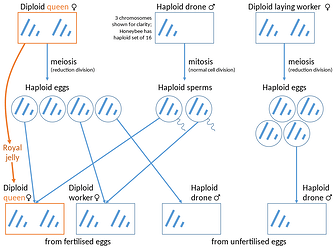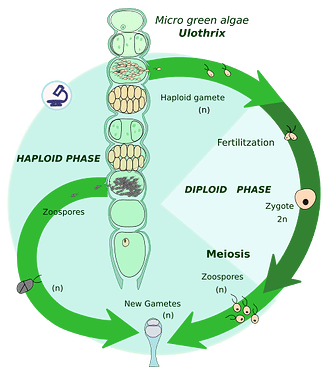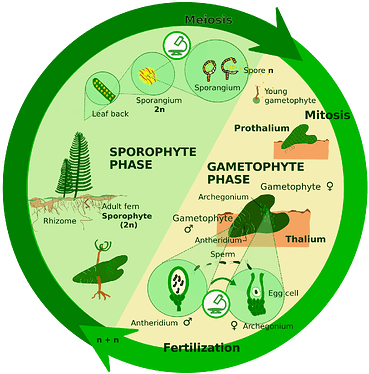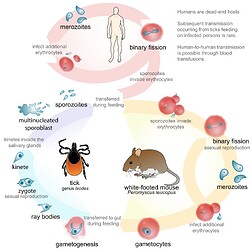Disclaimer
English is not the language I write it quickly (it alone took more than 7 hours to write it in my normal language before I translate it and try to fix the errors with third party software tools. Imagine if I wrote this in English directly ![]() ) and it could cause For brain disorders and uncorrected grammar. If there is anything that is not understood, I would be happy for you to ask and I will try to answer you.
) and it could cause For brain disorders and uncorrected grammar. If there is anything that is not understood, I would be happy for you to ask and I will try to answer you.
that also fit in the Science! category, but I see that more fit in the Future Game
Index and what to compensate for reading it:
-
Cell specialization - the first stage of the transition from unicellular to multicellular
-
The “colonial theory” and how does all this relate to cell specialization?
-
Effects of sexual reproduction on multicellular evolution
-
Between layers, tissues and organs
-
So, what exactly is true of the multi-cell versus the player?
-
Summary
In short for the restless
In this topic, it is about scientific information about how multicellular creatures and cell specialization shaped themselves during their initial evolution (the early multicellular stage), how reproductive cells are an important key basis in multicellular development, how the environment shapes them.
How cells also specialize and how accurate this section of the game should be.
We will very soon (as of writing these lines) reach the next stage of the game of the multicellular and aware stage and there are already several talks about how to make one of the most important multicellular characteristics.
I’m not the first to talk about it [1] [2] and I’m sure not the last to talk about it until this part is at least polished enough, but I want to do things differently this time - to talk about things that are not data will refer to what is understood above it, my opinion is how much it is worth delving into the game (reality versus Gameplay), provide information related to the topic and is it practical?
First of all, let’s start with the elephant in the room -
Cell specialization
It already exists in the game - when you first reach the early multicellular stage, you get the option to create a new cell, different from the stem cell, allowing the initial specialization of your creature.
As strange as it is, even if it’s probably not accurate according to what happened in reality, in practice, this is the best way to describe it, because it’s the best way to simply illustrate how it supposedly happened. It’s just easier to balance them in the game.
In reality, it happened completely differently - the specialization happened only after cells started to stick together and in the course of evolution it was preferred until the initial cell specialization began - that unity overcame the selfishness, and the initial specialization of the cells began in the first true multicellular creature.
But we have a problem of lack of information - a gap in the initial transition between unicellular and multicellular - what is the trigger that caused this?
Laboratories are trying to reproduce this situation and there are more than a few studies that talk about it, and of course, there were successes! When it comes to yeast.
Yeast are unicellular fungi, model cells (baker’s yeast [Saccharomyces cerevisiae]) that have been used in the laboratory for decades for many and varied studies - from food to cell metabolic research and even cancer research. But from an evolutionary point of view, they were originally a fungal multicellular organism (not all of them come from the same source, but most of them came from the phylum “Ascomycota” [3]).
The scientists decided to try to do laboratory evolution - to make a selection (artificial selection) for yeasts that show that they are together. Pick the desired traits and move them to another location while the others are destroyed. They repeated numerous times and succeeded in growing multicellular yeast.
But that’s easy because in the past they were evolutionarily multicellular and gave up partnership to survive and all this experiment did was reverse the situation. [4]
What they discovered in addition to this, is that an environmental factor is also related to the development of multicellularity, especially from a surprising direction - a lack of oxygen. It’s a delicate topic in the investigation, but if you want a summary of the topic, a video that links to it:
This connects to the question of the beginning of multi-cells, which many try to answer: what were the reasons for the transition from single-celled to multi-celled?
This is something that has been written about a lot here and a little deviated from the topic, but in short: was there environmental pressure that caused the transition from uniformity and loneliness that existed before their existence to life visible to the human eye?
It is a question that is still not his business and it is hard to find evidence for it. Admittedly, not long ago, we discovered possible evidence of cell complexity early on in a period that is very difficult to find evidence of the period of the “boring billion” (1.7 billion - 700 million BC).
A video that briefly explains it:
The presence of the existence of such multicellular forms (although still difficult to prove) in this period, only leads to the question of how short is the distance between the appearance of eukaryotes and the development of the first true multicellularity.
First of all, what gives multicellularity? You sacrifice your freedom for the good of the community, from the point of view of classical evolution, it lowers your chances of surviving and passing on those survival genes. In evolutionary terms, it’s a burden. But what about a creature that is made up of the same genes, even if one dies, the rest that share the same with you manage to survive? Evolutionarily speaking, this creature is successful.
It can be seen that eusocial creatures work on the same principle, only on a smaller scale. That strange feature of the universe that appears as “Emergence” that I won’t go into too much detail about here. [5]
And there are a lot of theories about how multicellularity started (for example “The symbiotic theory”, “The cellularization (syncytial) theory”, etc.[6]) but the game seems to follow the familiar theory:
The “colonial theory” and how does all this relate to cell specialization?
For a multicellular creature to be able to pass its genes on, it has to find a way to do it of course. Cell division (mitosis) is the simplest and most well-known way. Still, it is limited as far as it is possible in such a large creature: it requires a large amount of resources to perform such an operation - imagine if an entire human body did mitosis - they would have to go through whole days through whole cells and not to mention an evolutionary and ecological limitation that makes you particularly vulnerable.
Cells can do this because they are extremely small and also the budding that yeast does is possible for the same reason. There is evidence of larger multicellular creatures being able to do this (Hydra) but that is because they are simple or small enough that the advantage outweighs the disadvantage.
But what if we could let one cell among all the cells that collect cells be the only one to perform mitosis? It will save us a lot of resources and to do this and time and when he is released and won’t depend on his parent for too long. This is possible because the colony shares the same genes according to what was explained before, so even if one cell dies, the colony still contains the same genes as the dead cell, and the information does not disappear. This is an evolutionary advantage!
I won’t go into the details of how exactly this happened, because it’s still a matter of controversy, but this little essence gave a huge advantage over others that all the cells do mitosis on each other. Only if a certain type of cell has specialized in the reproduction of the rule since they contain the same section of information about their construction, this is an opening call for cellular specialization - other cells may have specialized in a different field that will give an advantage to the rule of the colony compared to its counterparts - more efficient use of the environment’s resources, higher performance And so on, and as long as there is at least a small group of cells that specialize in reproduction and contain the information of the rule and information of which cell divides into another cell (stem cells for example), there will be no evolutionary limit to them.
But there is one - the disadvantage of this type of reproduction of only mitosis (from this point we call them asexual reproduction) is that it adapts very slowly to the environment and includes that the first true multicellular colony is larger and more complex, the slower its growth, and the environment is cruel and merciless - both From the abiotic outsider (environmental changes) and the biotic environment member - competitors and predation, a creature that looks slowly at the rapidly changing environment, its fate is death and will not be able to pass the genes on.
For bacteria, this problem is partially solved by a feature that has only recently been thoroughly understood: horizontal gene transfer (HGT). By chance, stress, and luck, bacteria can borrow DNA segments from other bacteria, even unrelated ones, and integrate them into their genes. With luck, this can give them an advantage. This is how bacteria become resistant to antibiotics, but also causes problems in the study of the evolution of bacteria. [7]
But for multicellular production that uses a small group of cells that contains the genes of the total, if it does this, there is a good chance that it will not be able to pass on, another solution needs to be found.
And this solution is sexual reproduction.
This act of sexual reproduction existed long before the first multicell was formed. It has a heavy price (energy and material cost) compared to asexual reproduction, but its advantage is simple: the ability to adapt faster to the environment, outweighs the disadvantages. [8]
Theories to turn to: The “Red Queen” theory and the “Riverbank” theory explain the reason for the development of sexual reproduction, but when it comes to a multicellular creature, this is probably the most efficient way for them to adapt to the environment quickly when needed.
Effects of sexual reproduction on multicellular evolution
There are at least 25 separate instances where multicellular organisms have evolved, but of these, 6 are the most evolved: animals, plants, fungi, green algae, red algae, and brown algae, all of which have the means of sexual reproduction.
But how do they get to this stage, they are especially diverse to the point that each of these groups has a different way to reproduce and solve the problem of reproduction and adaptation to the environment
This article talks about it briefly in relation to oxygen, as I don’t think I can detail it here:
https://www.nature.com/articles/s41437-020-0317-9
As strange as it is, there are actually cycles of when it reproduces and when it doesn’t, determining how the creature reproduces and when it reproduces. According to what we know about the conditions on Earth, they are divided into stages according to what their genomic appearance looks like. This is called “sex determination”, as in our case it is XY, in many creatures it is determined in different ways: for example in birds it is W/Z (that ZZ is male and WZ is female) or in turtles the temperature determines the sex.
But when I talk about reproductive methods according to sex determination, I’m talking about stages of development. I only write about a small part of the spectrum, but these are the main ones:
- Haploid - a cell has one set of chromosomes (denoted as n in scientific writings)
- Diploid - a cell that contains two sets of chromosomes (marked as 2n in scientific writings)
- Polyploid - a cell that contains more than two sets of chromosomes (usually in pairs, such as 4n)
And in this way, we are actually able to divide the stages of reproduction: when the multicellular creature is in one state and when the creature is in another state, determines how the multicellular creature reproduces and looks during its life.
We will focus on humans, for the sake of simplicity, since most animals have the same Diplontic life cycle - where multicellular is diploid (2n) and unicellular is haploid (n):
Some of the exceptions in animals are in the eukaryotic societies of ants, bees and wasps, which are Haplodiploidy life cycle.
What this means - most of the life cycle of this multicellular creature is visible and multicellular.
In contrast, in some plants, most fungi and algae and some others using the Haplontic life cycle:
And most of the plants use a cycle similar to what was explained before about ants - Alternation of generations (or metagenesis):
There are other types of cycles that I didn’t mention, but that’s irrelevant. So how does this boil down to cell specialization to state and life cycle? According to all these life cycles, one scheme can be seen - cells specialize according to the situation, when they are multicellular and when not, what their function is as multicellular and when not. What you thought of as a multicellular organism as a multicellular organism is actually only one stage in the life cycle and it can be extremely complex.
For example, you can see the life cycle of a single-celled parasite:
Even though it is not a multicellular organism, it closely resembles the life cycle of a multicellular organism.
Reproductive cells as determining a true multicellular organism:
We can conclude that the specialization of reproductive cells in a multicellular creature is the most basic and probably the first to be specialized before the rest of the cell specializations happened. What separates a true multicellular creature from an early multicellular creature (which is similar to the current situation in the game) is reproductive specialization. When this happens, you can call the creature in front of you a ‘multicellular creature’
How does it currently look in the game in its current state?
As said… it describes exactly the situation it doesn’t show them. Admittedly, I don’t think it is possible at the present time, if at all, to translate the essence of the sex cells for the sake of playfulness, for all kinds of reasons:
- Taboo
- Seeing as how the game goes, it is still not defined and probably won’t be defined soon (as of writing these lines) what the late multi-cell stage will look like and if adding them to the game will be relevant or unnecessary.
- Difficulty programming such live stages or destroying the flow of gameplay.
So I believe when they get to that point, the best thing to implement them is to just add cells like this and move on, not to delve into it as much as it’s interesting. At least leave this to the non-existent mod community or leave this as a side job.
Between layers, tissues and organs
The current design of the direction of the game is in short (it is still vague and subtle in the discussion) to give the player the option to create special tissues according to the properties of the cells that the player created and use them to create tissues.
This on the one hand gives freedom to the player to design how the creature he is playing with will look, but on the other hand, a compilation is given that is not always friendly to perhaps more casual players or lovers of the game. I think one of the reasons for the success of the Spore game is because it tries to balance these two factors, even if at certain points it turns out to be disappointing.
I feel that very soon they will enter this point and try to think how far they want to go, but this is my opinion on the matter, and also links to the following topic and thinks to the same extent:
Matching structure to function
From the point of reproductive cell specialization, cells were freed from the need to reproduce in a disordered manner and began to synchronize mitotic reproduction and this led to the creation of the first tissues. It seems that in the first periods this seems to be an experiment of many mistakes and attempts. You can see this in slime molds - they don’t have defined layers, but they do have cells that specialize in reproduction (they have a completely different life cycle from what was mentioned in the way called Multinucleate, but that deviates from the topic).
Throughout development after the true multicells were created, it seems that competition between those ancient multicells led to a well-known physical obstacle - the ‘cube law’
This was explained earlier in this place:
But in short - as the size of any creature doubles, the surface area increases squarely and its volume 8 times.
This causes an obstacle that limits how much they are able to grow before their size no longer allows them to be maintained since materials at that time could only pass through their surface, at a certain point, the volume consumption will exceed the surface area of the creature, it will starve or suffocate to death due to its large size.
So what is the solution to circumvent this as a creature that has just started to become multicellular?
Folds.
Folding of rows of cells and gathering into themselves indirectly allowed to increase the surface without increasing the volume, allows to overcome this problem on a certain level. You can see in the mitochondria how much it is folded in order to increase its surface area so that it can produce more ATP since its proteins are only on its membrane.
But there is a limit to how far you can fold and how effective the folding is. In an early multicellular organism from the point of origin depending on which cells he started with, he encounters different problems around what he has: for autotrophic cells, they are able to generate energy by themselves as well as the passage of oxygen and air between cell layers can reach up to 1 cm [13]
And folding focuses mainly on protecting reproductive cells (inserting them deeper into the organism) or inserting minerals deeper into them, but not in a particularly complex way. They can be seen today in various marine algae as a living illustration of this situation.
In contrast, heterotrophs are unable to produce food and therefore must obtain it in another way. For them, a different way is required to overcome this problem.
In fungi, he found this by the passage of nutrients between the cells, bypassing the problem of size up to a certain level, because since their cells contain a cell wall, folding is limited in their period and it can be seen that to this day they produce mycelium long webs of single cells.
In creatures that came to be animals, because the cells are relatively more flexible, the first folding began which in the future will become the first gram layers.
The second cell specialization that, together with the reproductive cells, in animals began to form two different layers:
-
Ectoderm - the outer layer where the cells are outside during development - the cells that specialize in it in the future will be skin and neuronal cells and everything related to them (brain, hair, etc.)
-
Endoderm - the inner layer that folds to become the digestive tract - in which the cells specialize in the future into different cells such as different digestive cells, liver cells, lungs, etc.
The separation, specialization and folding into these two layers gave them an advantage that both bypasses the cube law problem and also opens up the option for a safer and more accessible place to put food into the other cells in the multicellular creature’s body.
From this point, the specialization of cells for their location and function in the tissues created by the folds, gives by trial and error during evolution and opens up more possibilities for development and specialization for the future of the creature.
In the future of animal evolution, a third gram layer was created:
- Mesoderm - the middle layer - from which muscle and blood cells will be formed in the future.
Evolutionarily speaking, we have all three gram layers and they can be best distinguished at the blastera stage of embryonic development before the cells divide later.
Later than this point, it is already history: Cells with different specializations developed during evolution, leading to the future creation of organs from the same tissues as the specializations of cells grew to the state we see today.
But everything is based on one thing - a cell comes from another cell.
Even though all these cells are genetically compatible with each other, their shape, function and location are completely different from each other. Everything stems from one point scientifically:
Epigenetics [14] - opening and closing features in the cell by methylation without interfering with the genes themselves. Locking features while unlocking others, tailoring the cell’s role even further allows it to work without undergoing major genetic change. Can also explain why we have all the information but cells are different from each other.
This is a relatively new field of genetic science and is also attributed to it in various fields of medicine for genetic or developmental diseases such as autism and Alzheimer’s, but it can also perhaps help us understand the point of how cells differentiate exactly.
This is a field called “developmental biology”, but that is a topic for another time and there is not enough information on this topic [since it relates more to embryonic development than multicellular development].
So, what exactly is true of the multi-cell versus the player?
After all the information overload I’ve presented here, what can be concluded about how precise the development of multicellular creatures and cell specialization should be for the game itself?
Here this is my absolute opinion and here I think you should take this with a grain of salt, as I am not a game designer.
The question asked by the developers is how to do this correctly - how accurate is it possible to do this and what should be removed and what should be added.
Simplicity versus complexity.
I explained in the section with the specialization of the reproductive cells that a life cycle is unique to every living being but its complexity can only complicate the average player and therefore if we want gameplay versus reality, I would at this point go for gameplay, but include them as the first before the other cells for the reasons I listed above.
But what about the other cell types and specializations?
This is a difficult question due to the fact that I am not a game designer but a student in my last year for a bachelor’s degree in life sciences, and I say this from a scientific point of view, not a game one.
I think the most correct approach regarding designing cell specialization and later tissue is a very blurred line - how simple can complexity of this kind of line be?
Cells not only have different customs in specialization, they also change their shape drastically during their specialization - for example, a muscle cell has actin fibers that are intended for action, in nerve cells they use the same fibers and wrap them around themselves to create insulation for signal transmission. Same material, different role.
I feel that it is right to do, as one of those simple players, something that resembles a hierarchy rather than go into the details and match which cell to cell exactly, that is to do something that resembles a range.
Maybe there is a cell you created that contains a lot of lysosomes suitable for digestion of course, but it is also suitable for an immune system, which needs to digest dangerous things such as pathogens. If it can be hybridized with another cell of another type, which can fix nitrogen, then together it can create another type of tissue that specializes in getting rid of waste and converting it into a vital substance or something similar to kidneys, along with a list of features on the side that is possible after you choose the cells you want to match with the tissue you created and adding the desired feature to it (such as cells full of lysosomes, muscle cells and a feature that relates to digestion and then putting it into a creature), you will not limit creativity while maintaining the simplicity of wanting it that way.
The problem that, in my opinion, arises from my idea is simply a complex sophistication of programming - if you want a certain type of cells with different properties without matching them to one of the list of properties, you can make it automatic and let it run wild.
Making a list like this is a Sisyphean story that is simply full, so you can start with the most important and simplest, by downloading reproductive cells, of course, and perhaps expand later - for example, build the seed of the reproductive cell that is surrounded by cells of a protective type, and creates the seed of a plant, or alternatively , placenta.
But here I am, already throwing nonsense, this is my idea and my opinion regarding the specialization.
Summary
The formation of multicells is still shrouded in mystery, as such evidence is still difficult to find or reproduce. But thanks to theories, alternative evidence and experiments to connect several dots that may not be true, we are at least able to get a picture of how this process took place.
Because of the complexity behind the subject, in the war between accuracy and playability, this is a step that is not particularly easy to convert accurately without harming its playability or at least it will be difficult. I’m not a complex programmer or game designer, but I’m here an avid science lover and a simple gamer who wants to see the best of both worlds come into one, but the right question is not how to do one, but what is the most profitable way to do one without harming the other.
It’s not my decision, I have a hand in it, it’s a simple “person” muttering things to him in the frozen void of himself, trying to contribute his hand that even in his difficult conditions, trying to see this game cooked to be the most perfect it can be, with the best people we could all ask for, and at least be a milestone in it.
in one way or another.



